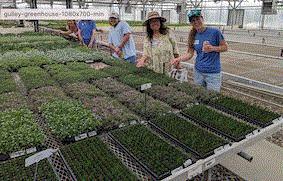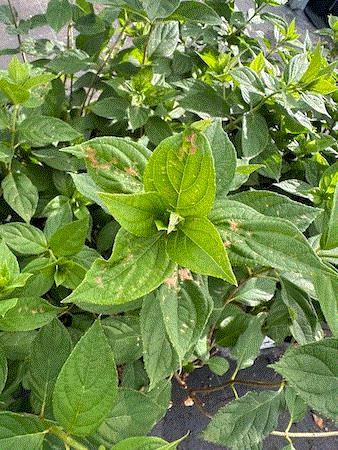What’s Happening Here?
One of the challenging aspects of growing plants is how quickly a problem can arise, causing a seemingly healthy crop to appear otherwise. Earlier this spring a grower asked if I knew what was happening to her shrubs. Check it out.
She observed these symptoms on several types of shrubs growing inside her greenhouses. The symptoms looked familiar to me, but I’ve only seen them on plants being grown outside, not inside, of greenhouses. That’s the only clue I can give at this time.
Does this look familiar to you? If so, lock in your answer and continue reading. If you’re still contemplating the possibilities, relax and take your time as you narrow down your choices. I’ll reveal the answer before signing off for the week. It’s time for me to ask: what’s happening here?
Smokey Mountain Mint
Please allow me to introduce you to one of the newest introductions from
Intrinsic Perennial Gardens. It’s none other than
Pycnanthemum x incanum Smokey Mountain Mint. This hybrid incanum is an absolute pollinator magnet. Smokey Mountain Mint has gray-purple foliage with silvery growing points. It grows 24- to 30-in. tall and produces tons of flowers from early summer through frost. As its name implies it does have a pleasant minty fragrance. Hardy to Zone 4. I’m not sure what the availability in the industry for this new introduction looks like at this time, but I do see liners can be purchased from
Growing Colors.
Colorado Destination Days
If you’re looking for an excellent reason to travel to a beautiful area and visit some incredible horticultural companies and venues, look no further than the upcoming Colorado Destination Days. This summer you can join your fellow growers, suppliers and plant enthusiasts as they explore the exciting new plant varieties and horticultural products at numerous horticultural facilities in Colorado.
|

Gulley Greenhouse and Garden Center
|

Chatfield Farms
|
Colorado Destination Days is a multi-day horticultural industry event and is not open to the general public. An RSVP is requested with each facility you wish to attend. Simply click on the name of the venue above to obtain event and registration information. I hope you enjoy your time in the Rocky Mountain state if you’re able to attend.

CSU Flower Trials
You may have noticed the Colorado State University Trial Gardens are one of the venues participating in Colorado Destination Days, but what you may not have realized is CSU is hosting their Flower Trials Industry Evaluation Day on the same day and time as the above event. How cool is that?
What: 2024 Colorado State University Flower Trials Industry Evaluation Day
When: Tuesday, August 6, 2024 from 9:00 a.m. until 1:30 p.m.
Where: Colorado State University Trial Gardens—Fort Collins, Colorado
You’re cordially invited to tour the gardens and participate in the evaluations. There are over 1,000 annual trial entries planted in containers or in the ground featuring over 250 NEW varieties. The 3-year Herbaceous Perennial Trials consist of approximately 300 different perennials with over 100 new entries for 2024.
Please RSVP for the event by July 30 at 5:00 p.m. MDT using the following link:

The Answer Is ...

I shared this image at the top of the newsletter and asked if you know what was causing the leaves of these shrubs to look this way.
Before the big reveal, I’d like to add the shrubs were grown outside last summer, moved inside structures to be overwintered and grown inside the greenhouses earlier this year. I previously mentioned that I’ve only seen these symptoms on plants grown outside but I find it peculiar and even likely there is a connection between the current symptoms and the fact that these plants were outside last summer. I can tell you with certainty that is the case here, the problem did originate outside. I’ll narrow the possibilities with one final clue: the symptoms are from insect feeding.
Are you ready to see if you figured it out?
If you answered red-headed flea beetle, you impressively solved the challenge. Read on to learn more.
RHFB
Red-headed flea beetles (RHFB), Systena frontalis, are small 0.25 inch (6 mm) long beetles with shiny black exoskeletons and reddish to light brown heads. They’ve become quite a challenging pest for nursery growers in recent years. The adults eat holes or skeletonize leaves of numerous broadleaf woody ornamentals and herbaceous perennials quickly decreasing the plant’s appearance and marketability.
RHFB lay eggs in the growing mix, which give way to multiple generations including the last generation, whose eggs overwinter in the root zone. The creamy white larvae (0.4 inch or 10 mm long) with light brown heads and three pairs of legs feed on the roots; larvae feeding does not seem to have a major impact on ornamentals.
Circling back to the challenge. RHFB adults laid eggs in the growing mix last summer when the plants were grown outside. The eggs overwintered and emerged while the plants were in the greenhouses.
Interested in learning more about red-headed flea beetles and how to manage them? I have your back—check out the following links:




Thanks for reading this edition of Perennial Pulse. My email is paul@opelgrowers.com if you have any comments, article suggestions or if you'd just like to say hello.
Best regards,

Paul Pilon
Editor-at-Large—Perennial Pulse
Director of Growing—Opel Growers
This email was received by you and 34,516 other fine subscribers!
If you're interested in advertising in Perennial Pulse, contact Kim Brown ASAP and she'll hook you up.